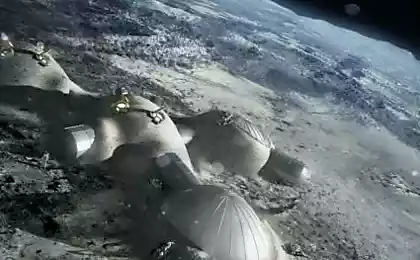2223
Plant with adzhika Chlorellales in broth or something to eat on the way to Mars
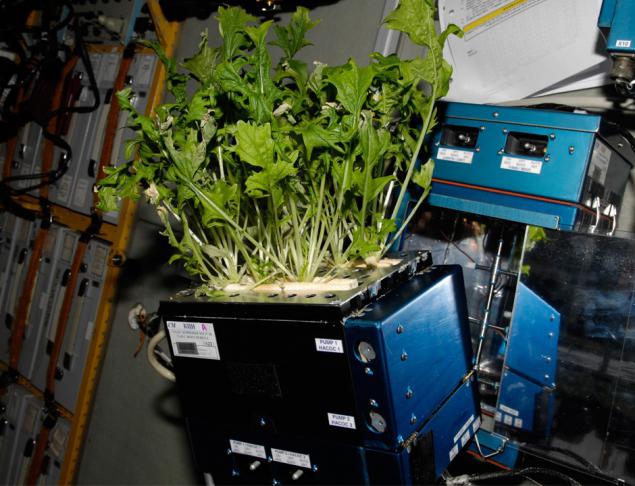
Current status of rocket engines tells us that the way to Mars will be long. Flight on a ballistic trajectory without an engine takes about two years, and having little traction electric propulsion will not greatly reduce the life of the flight. In such conditions, the list of important issues is catering. The food, unfortunately, has a weight, which must disperse to Mars, the crew produces waste that must be disposed of or recycled, in general, the various engineering challenges this creates a lot of trouble. About them and we'll talk.
History of Space Food h4> is now used on the ISS food differs little from ordinary earth. Canned, sublimated abbr> products, with a cargo ship brought fresh fruit. Is that the quality is guaranteed and canned surely not overdue. Such food is certainly tasty and nutritious, it is diverse, and contains little delicacies and well regarded in terms of psychology. But it is not very effective in terms of maximum weight and volume savings for a long flight. But first let's look at its history, what changes it has undergone, and as such what is has become.
The first experiments h5> The main factor that takes into account the developers of space food on both sides of the ocean was weightless. The food was not to crumble, spill or fall apart, so as not to cause a short circuit. Therefore, the decision that in the USSR that the US had the same - nekroshaschiysya bread (in the US it still covered with a special mixture against crumbs), packed in plastic into small pieces and puree in tubes:
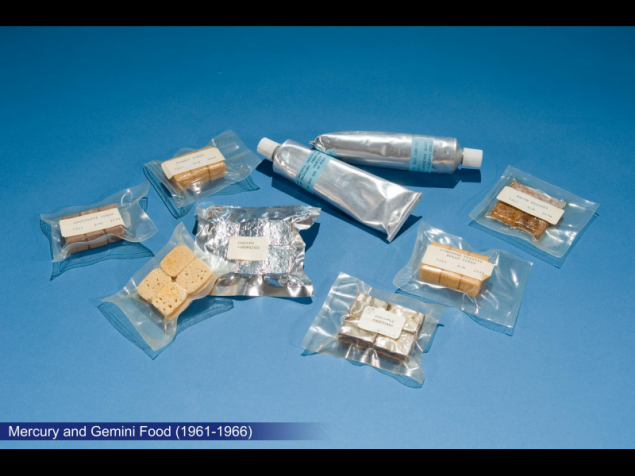
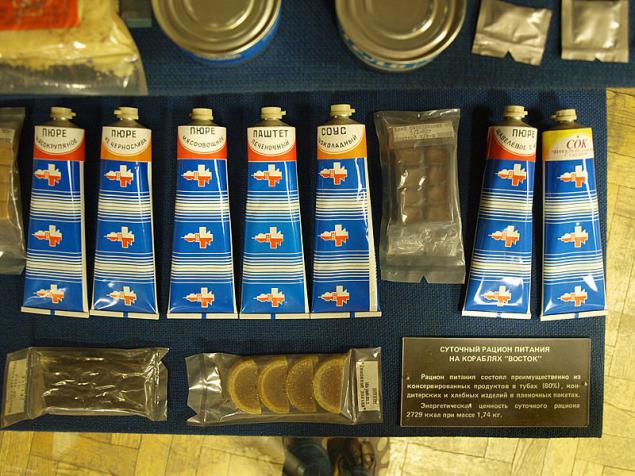
The solution turned out so-so. Firstly, after experiencing weightlessness proved that it is not so scary. About surface tension forces developers food seems to have forgotten. Because they ensure that water does not crumble into a thousand drops arrange short-circuit, and would be culturally hanging ball, which can already be controlled. Even rice can be eaten in weightlessness, even with a spoon, almost like on Earth if its glue sauce. Secondly, the nutritional value of the food was not enough. Despite estimates of calories astronauts complained of hunger. Thirdly, the food was not very tasty. Adipose shell sandwich cubes USA spoil the taste and texture of mashed potatoes were deprived of "normal" food and reminds sauce. The longest flight at such a meal was two weeks ("Gemini 7") and demanded that the astronauts certain willpower.
Sublimation and breeding h5> extremely useful for space became sublimation technology. In the physics of sublimation - a transition from solid to gaseous state. If we freeze the food and place it in a vacuum chamber, the water ice evaporates, bypassing the liquid phase. Products will retain its shape, smell, color, and nutrients. Thus dried food may be placed into the plastic already in space dilute hot or cold water to give good nutrition.
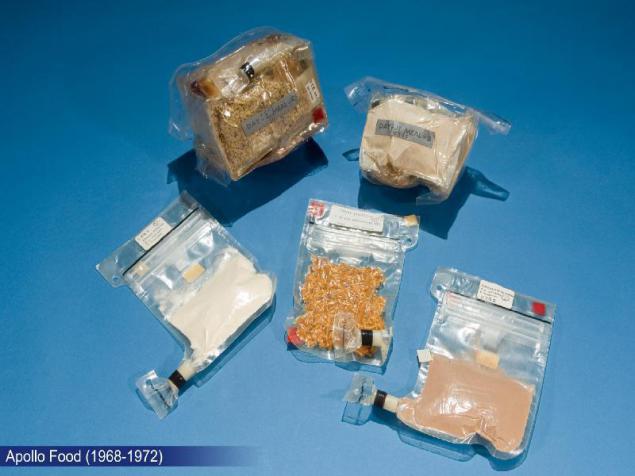
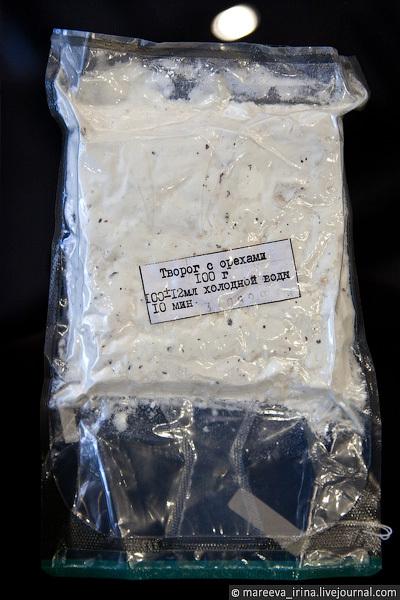
In the USSR, to sublimate products added canned conventional banks
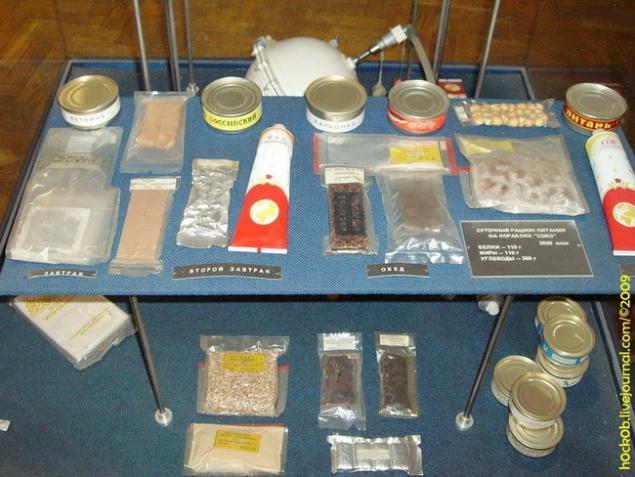
Diets of this type flown on American "Apollo" and the Soviet "Union».
Wealth orbital stations h5>
To the space station had more space, you can hang at the table with their own tray of food. The diet is practically remained unchanged. Is that on the station "Skylab" wanted to add to the menu table wine, but because of public anger, these plans were canceled:
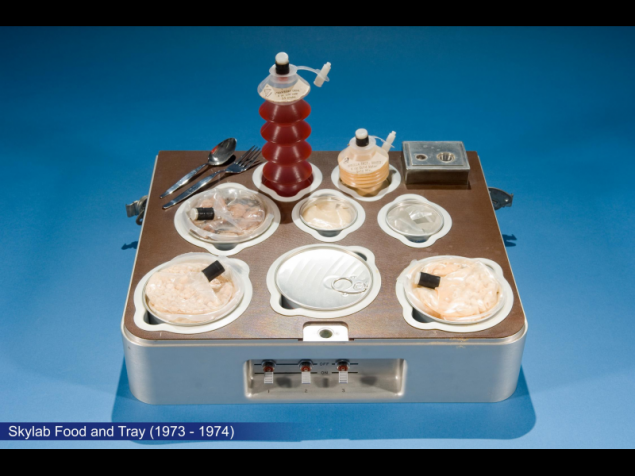
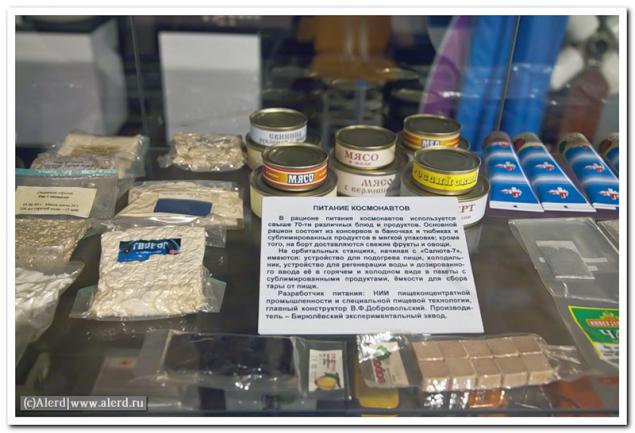

Shuttle and ISS h5> Modern food is based on the same principles. Diet collected from freeze dried foods, canned routine (the Americans in the packages, we at the bank), bread (in the US are used nekroshaschiesya cakes, we have - portion bread), biscuits and sweets, as well as dry drinks or tea bags in plastic. < br />
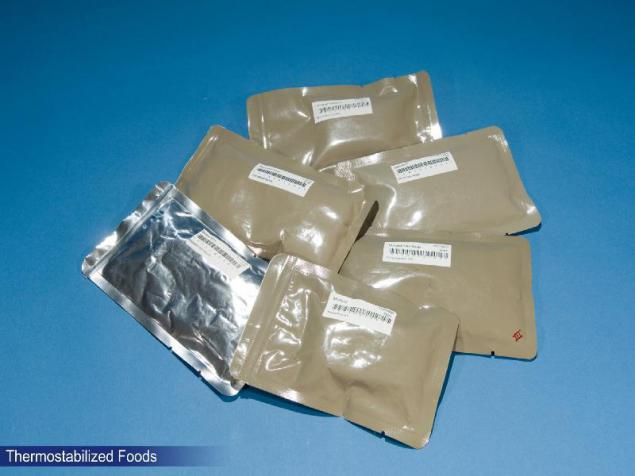
Canned heat treated in packages i>
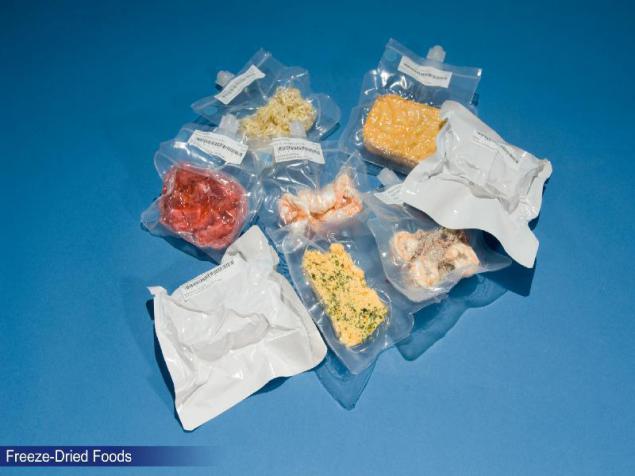
Freeze-dried products i>
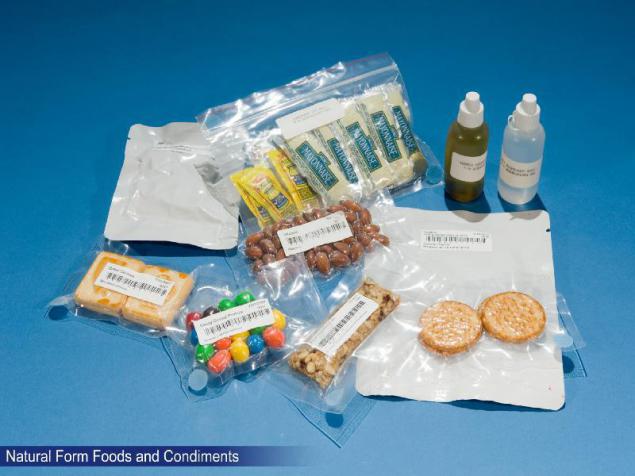
The sauces, biscuits, chocolate i>
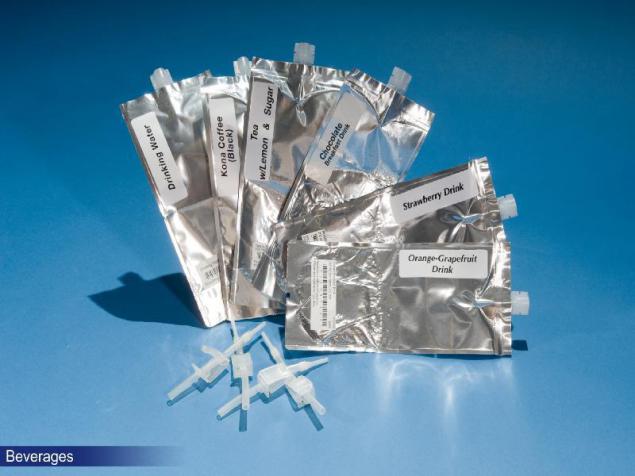
Packed drinks i>
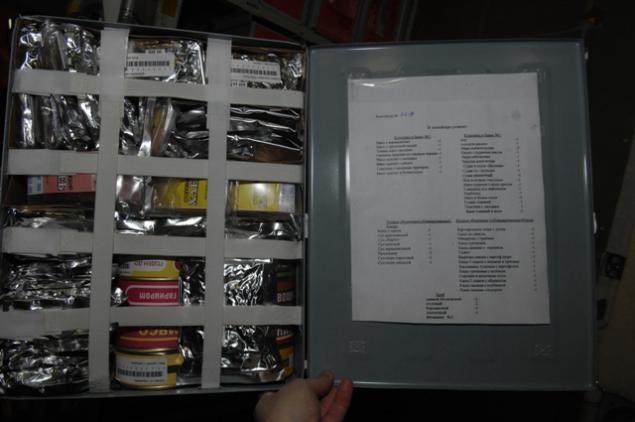
The box with the Russian diet. Different banks instead of canned packages and cuisine - we certainly more tea in beverages. I>
Results h5> Of course, not all types of products are on the ISS, and the astronauts sometimes miss dumplings or fried potatoes, but overall the food is not very different from Earth's. But it comes at a price - the food is heavy, yet adds some weight package. During 2013 the ISS went 4 "Progress" under one HTV, ATV, Dragon and Cygnus. Ie was delivered into orbit about 4 * 2500 + 6000 + 5500 + 3300 + 2000 = 26800 kg of cargo. Of course, not all of this food, but about 15 tons of food and water was brought to the ISS. If we're going to Mars for two years, then the weight will be about 30 tons. Frankly, unpleasant figures. And is there any ways to reduce this burden? Scientists from around the world a lot of thought about it.
Alternative Diet h4> Even before the first flight of a man into space, the various people and organizations to develop a nutrition program in space flights. Such programs have been created very much: liquid diet (milk shakes, eggnog-diet), nutritional sticks, cubes and balls, but all of them different is that they do not show themselves on the tests. We can not say that the people involved in these tests, showed heroism almost more than the astronauts because they had to eat these experimental diets for longer than the then lasted for space flights.
Unrestrained imagination drew more and more exotic ideas - mouse farm as a source of meat, edible paper, clothing, and parts of the spacecraft, but it did not reach even to the stage of the experiment.
Closed loop h4> A special case is the idea of using the ship closed-loop life support. Plants / algae consume carbon dioxide and waste products of the crew, and release oxygen and produce food. In theory, this is the most convenient option. But, of course, attempts to actual implementation encountered various problems.
Chlorella summed h5> 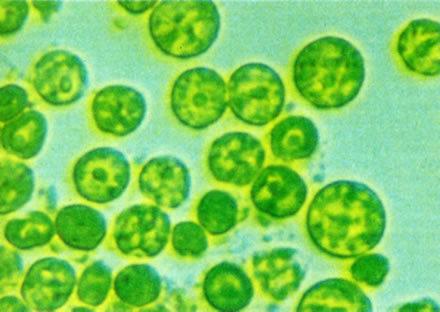
Scientists and science fiction set on the throne of the life support system of the closed cycle of unicellular algae Chlorella. Indeed, unpretentious living in puddles and ditches algae produces oxygen and multiplies, requiring only water, light, carbon dioxide and a few minerals. Chlorella theoretically nutritious wheat, since it contains 45% protein, 20% fat and 20% carbohydrate. But all these dreams were smashed by the fact that man is not digestible chlorella - too thick cell wall is not available for digestion by human enzymes. In principle, modern technology has to offer at least three ways to solve this problem: the splitting of the cell wall of technological methods (heat treatment, fine grinding or something else), biological methods (take with enzymes that break down the wall and add them to the food), or withdraw from GMO chlorella available for splitting the wall. Unfortunately, at present some notable work with chlorella are only commercial firms that sell it as a dietary supplement ( article on Wikipedia , edited in summer 2013), or as an additive for animal husbandry, which is sad enough in terms of provide space flights.
The moral problem h5> at "News of Cosmonautics" I once read a post by PMU staff (quote from memory): "Hard working day - fans ran closed-loop life support, watered all recycled urine, luckily I was able to quietly escape. " Alas, the need to drink recycled urine causes psychological rejection, which would complicate and so psychologically heavy long flight. The system, which regenerated water from the water, breathe the air, condensate and other perceived normally, so the SRV-K (the system of condensate water recovery) worked with the first orbital station "Salyut" and now stands on the ISS. But SRV-U (system water recovery from urine) was only at the station "Mir", and the ISS recycled water from the urine goes to the electrolysis abbr> and from it receive oxygen for respiration.
Successful experiments h4> At the same time, in the USSR were quite successful experiments on closed systems, BIOS-2 and BIOS-3. BIOS-3 was launched in 1972 and operates today (Online Report for 2012, the news of the closure of the web is not). Initially, the project had four sealable compartment (two phytotron for plant growth, one cultivator for algae - regeneration of the atmosphere and the living compartment) totaling 315 m ^ 3. In phytotron cultivated extensive range of specially selected plants (wheat, soybeans, lettuce, Chufa, carrots, radishes, beets, potatoes, cucumbers, sorrel, kale, fennel, onions), and conducted experiments on "autonomous flight" for up to six months. The results are impressive - in the air and the water reached almost 100% closed loop on food - 50-80%. Complex restructuring and survived a nightmare 90 and, according to the official website, modernized and takes part in international programs.

A general view of the complex i>

Phytotron i>
Conclusion h4> In general, in terms of ensuring food long expedition, humanity fairly good position. Even at the level of technology 70-80s BIOS-3 experiment is encouraging, and the spread of the technology of genetic modification can give us even more space efficient plants. Also constantly working with plants on the ISS.
Additional Resources h4> Very interesting film "Ways of life support in space", considered and physicochemical (SRV-K, Y) and biological (BIOS-3) methods
The recent launch of the program "Space." It is worth noting the positive effect of the plants on the psyche and be glad for the younger generation, which tends to work in this direction in the future.
"Space Odyssey, century XXI», issues of food with 14 minutes.
International Center closed biological systems, BIOS-3 site
Системы chemical regeneration NIICHIMMASH
Источник Food pictures NASA , recommend looking photos in large size, are visible bilingual signature product names and instructions for use.
More photos of modern food to the ISS
For photos of food from museums thanks to bloggers whose copyrights are shown in the photographs.
I recommend reading the book "The downside of Cosmonautics" by Mary Roach. About the food there at the end, very curious.
They say there is still a book "Cookbook astronaut," but I did not read, can not say anything.
Source: habrahabr.ru/post/223211/
Arecibo Observatory has confirmed the existence of the universe in a new type of super-powerful radio sources
Simple Science - digest experiments # 32























